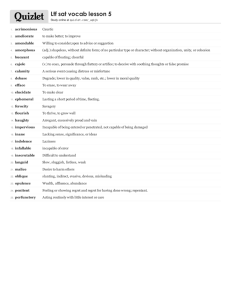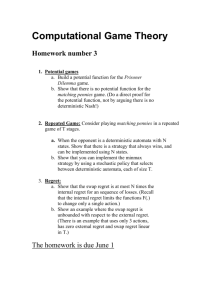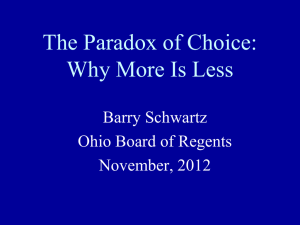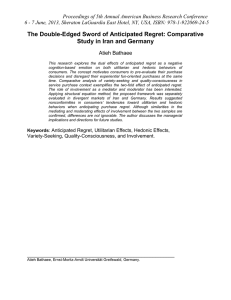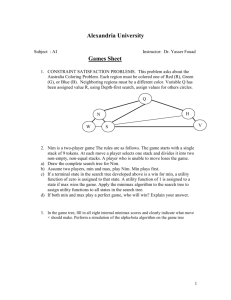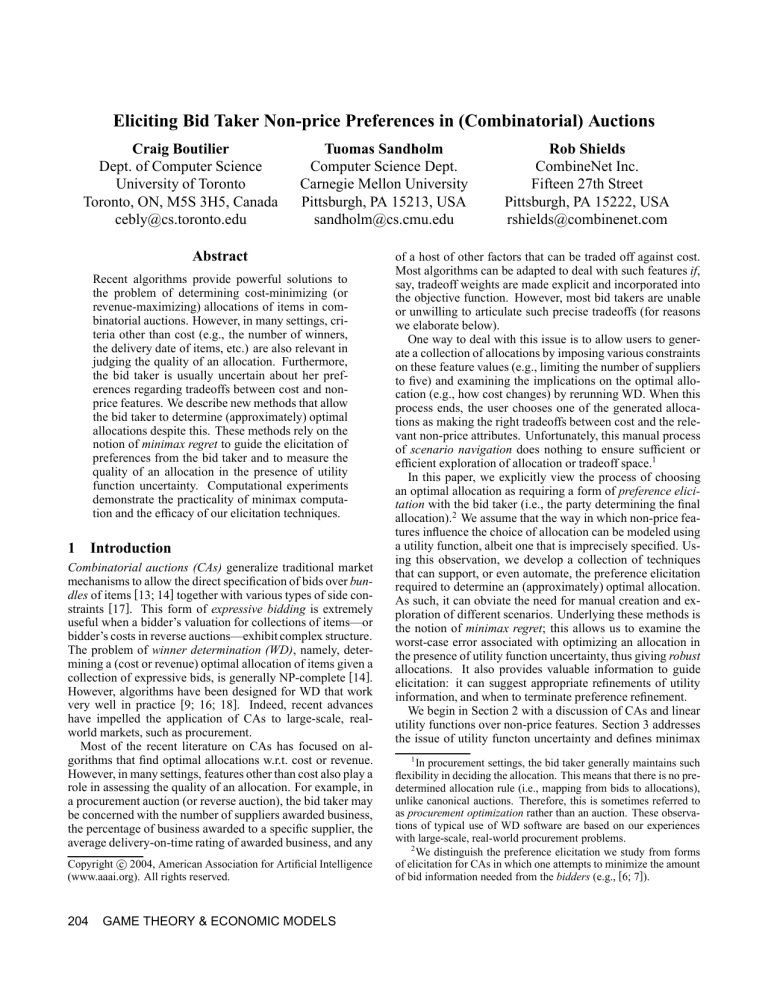
Eliciting Bid Taker Non-price Preferences in (Combinatorial) Auctions
Craig Boutilier
Dept. of Computer Science
University of Toronto
Toronto, ON, M5S 3H5, Canada
cebly@cs.toronto.edu
Tuomas Sandholm
Computer Science Dept.
Carnegie Mellon University
Pittsburgh, PA 15213, USA
sandholm@cs.cmu.edu
Abstract
Recent algorithms provide powerful solutions to
the problem of determining cost-minimizing (or
revenue-maximizing) allocations of items in combinatorial auctions. However, in many settings, criteria other than cost (e.g., the number of winners,
the delivery date of items, etc.) are also relevant in
judging the quality of an allocation. Furthermore,
the bid taker is usually uncertain about her preferences regarding tradeoffs between cost and nonprice features. We describe new methods that allow
the bid taker to determine (approximately) optimal
allocations despite this. These methods rely on the
notion of minimax regret to guide the elicitation of
preferences from the bid taker and to measure the
quality of an allocation in the presence of utility
function uncertainty. Computational experiments
demonstrate the practicality of minimax computation and the efficacy of our elicitation techniques.
1 Introduction
Combinatorial auctions (CAs) generalize traditional market
mechanisms to allow the direct specification of bids over bundles of items [13; 14] together with various types of side constraints [17]. This form of expressive bidding is extremely
useful when a bidder’s valuation for collections of items—or
bidder’s costs in reverse auctions—exhibit complex structure.
The problem of winner determination (WD), namely, determining a (cost or revenue) optimal allocation of items given a
collection of expressive bids, is generally NP-complete [14].
However, algorithms have been designed for WD that work
very well in practice [9; 16; 18]. Indeed, recent advances
have impelled the application of CAs to large-scale, realworld markets, such as procurement.
Most of the recent literature on CAs has focused on algorithms that find optimal allocations w.r.t. cost or revenue.
However, in many settings, features other than cost also play a
role in assessing the quality of an allocation. For example, in
a procurement auction (or reverse auction), the bid taker may
be concerned with the number of suppliers awarded business,
the percentage of business awarded to a specific supplier, the
average delivery-on-time rating of awarded business, and any
Copyright c 2004, American Association for Artificial Intelligence
(www.aaai.org). All rights reserved.
204
GAME THEORY & ECONOMIC MODELS
Rob Shields
CombineNet Inc.
Fifteen 27th Street
Pittsburgh, PA 15222, USA
rshields@combinenet.com
of a host of other factors that can be traded off against cost.
Most algorithms can be adapted to deal with such features if,
say, tradeoff weights are made explicit and incorporated into
the objective function. However, most bid takers are unable
or unwilling to articulate such precise tradeoffs (for reasons
we elaborate below).
One way to deal with this issue is to allow users to generate a collection of allocations by imposing various constraints
on these feature values (e.g., limiting the number of suppliers
to five) and examining the implications on the optimal allocation (e.g., how cost changes) by rerunning WD. When this
process ends, the user chooses one of the generated allocations as making the right tradeoffs between cost and the relevant non-price attributes. Unfortunately, this manual process
of scenario navigation does nothing to ensure sufficient or
efficient exploration of allocation or tradeoff space.1
In this paper, we explicitly view the process of choosing
an optimal allocation as requiring a form of preference elicitation with the bid taker (i.e., the party determining the final
allocation).2 We assume that the way in which non-price features influence the choice of allocation can be modeled using
a utility function, albeit one that is imprecisely specified. Using this observation, we develop a collection of techniques
that can support, or even automate, the preference elicitation
required to determine an (approximately) optimal allocation.
As such, it can obviate the need for manual creation and exploration of different scenarios. Underlying these methods is
the notion of minimax regret; this allows us to examine the
worst-case error associated with optimizing an allocation in
the presence of utility function uncertainty, thus giving robust
allocations. It also provides valuable information to guide
elicitation: it can suggest appropriate refinements of utility
information, and when to terminate preference refinement.
We begin in Section 2 with a discussion of CAs and linear
utility functions over non-price features. Section 3 addresses
the issue of utility functon uncertainty and defines minimax
1
In procurement settings, the bid taker generally maintains such
flexibility in deciding the allocation. This means that there is no predetermined allocation rule (i.e., mapping from bids to allocations),
unlike canonical auctions. Therefore, this is sometimes referred to
as procurement optimization rather than an auction. These observations of typical use of WD software are based on our experiences
with large-scale, real-world procurement problems.
2
We distinguish the preference elicitation we study from forms
of elicitation for CAs in which one attempts to minimize the amount
of bid information needed from the bidders (e.g., [6; 7]).
regret as a suitable criterion for robust decision making. In
Section 4 we define several techniques for computing minimax optimal allocations in CAs under different forms of utility function uncertainty. Section 5 describes two methods for
preference elicitation based on minimax regret, and empirically evaluates these strategies on random problems with realistic structure and size, demonstrating the feasibility of our
methods. We conclude in Section 6 with a discussion of future research.
2 CAs and Non-price-based Utility
We begin with a discussion of relevant concepts relating to
CAs and utility for non-price features.
2.1
Combinatorial Auctions
CAs have found recent popularity as market mechanisms due
to their ability to allow expressive bids reflecting the complex utility structure of market participants. As a result, economically efficient allocations of goods and services can be
found using combinatorial bids in cases where noncombinatorial bids would not suffice. Recent research has focused
on the problem of winner determination in various classes
of CAs: finding an optimal allocation w.r.t. cost or revenue.
While a computationally difficult problem [14], recent advances in optimization methods for CAs have made them a
practical market technology [9; 16; 18].
The WD problem for a generic CA can be formulated as an
integer program (IP). In this paper, we focus on reverse CAs
where the goal is to obtain a collection of items at minimal
cost, since procurement is a main motivation for our work.
However, this is for concreteness only—all of our techniques
apply mutatis mutandis to most variants of CAs (see [19] for
a discussion of a number of such generalizations).
In a reverse CA, a buyer (bid taker) wishes to obtain a specific set of items G. Sellers submit bids of the form hbi , pi i,
where bi ⊆ G is a subset of items, and pi is the price at which
it is offered. Given a set of bids B = {hbi , pi i : i ≤ m}, we
let an allocation be any subset of B. A feasible allocation is
an allocation whose bids cover all items in G. The WD problem asks for the feasible allocation that supplies G as cheaply
as possible, and can be formulated as a (linear) IP. Letting qi
be a boolean variable denoting that bid hbi , pi i was accepted,
we wish to solve:
X
qi ≥ 1, ∀g ∈ G
min pi qi s.t.
i:g∈bi
Note that we assume free disposal (i.e., obtaining multiple
copies of any g incurs no penalty). This problem can be generalized to include multiple units of each item, no free disposal, various side constraints on the part of the sellers or the
buyer, etc. Notice, however, that existing methods determine
the optimal solution by minimizing only the (possibly constrained) cost of obtaining G.
2.2
Linear Utility for Non-price Features
While cost minimization is a primary objective in procurement, other features of the ultimate allocation will often play
a role in assessing the quality of that allocation. For example, the buyer may prefer to deal with fewer suppliers, all else
being equal, in order to minimize overhead. While a hard
constraint might be imposed on the number of suppliers (e.g.,
less than five), this approach is undesirable, since rarely is a
buyer unwilling to consider a larger number of suppliers if
that reduces cost significantly. Instead there is a tradeoff—
one is willing to pay more for a collection of items if the
number of suppliers is less. There are a number of properties
that are often used in procurement—to use just one domain
of application—to assess the quality of allocations. Among
these are: number of winners; (possibly aggregate) quality of
certain items; percentage of volume given to a specific supplier; geographical diversity of winners; and many others.
Tradeoffs between price and non-price features can be captured by the buyer’s utility function. We let X denote the set
of feasible allocations given bids B. Let F = {f1 , . . . , fk }
be a set of features over which the buyer has preferences. We
assume that the buyer’s preferences for allocations x ∈ X can
be expressed by a quasi-linear utility function of the form
k
X
wi fi (x) − c(x),
(1)
u(x) =
i=1
where c(x) is the cost of the allocation. Thus the utility function is completely characterized by a set of tradeoff weights
wi that express how much of each feature the buyer is willing
to sacrifice for a given amount of money. We assume local
value functions vi that convert any non-numeric fi (x) into a
numeric value vi (fi (x)); but we suppress mention of vi for
notational clarity.
Let w = hw1 , . . . , wk i denote a weight vector. We assume
all weights are non-negative (i.e., w ≥ 0), which implies that
higher levels of each feature are preferred to lower levels.3
We will use the notation u(x; w) when we wish to emphasize
the fact that utility is parameterized by a weight vector.
The independence and linearity of the local utility functions inherent in our formulation are, admittedly, fairly strong
assumptions, but nonetheless often (roughly) hold in practice.
Our techniques can be generalized to nonlinear local utility
functions and conditionally independent features through various encoding tricks. We also assume that each feature fi (x)
can be defined linearly in terms of attributes of allocation x.
Again, if this is not so, certain approximations are possible.
We briefly discuss these generalizations in Section 4.4.
3 Utility Function Uncertainty
In this section, we develop techniques for computing robust
allocations when the parameters of the utility function are not
precisely specified.
Given a known weight vector w, our objective would be
clear—find the feasible allocation x∗w with maximum utility:
maxx u(x). A number of WD algorithms can be adapted
to this linear optimization problem. Unfortunately, buyers are usually uncertain about their tradeoff weights. This
should not be surprising; the decision analysis literature is
rife with evidence that decision makers have trouble constructing precise tradeoff weights [11]. And numerous methods for decision making and elicitation have been developed
3
For instance, if fewer winners are preferred to more, the relevant
feature is negative number of winners.
GAME THEORY & ECONOMIC MODELS 205
that account for this fact, both within decision analysis [23;
15] and AI [10; 5; 2; 4]. Furthermore, in procurement, the
buyer is often faced with the difficult task of aggregating the
preferences of multiple stakeholders via internal negotiation
within the buying organization (the CFO preferring low cost,
marketing people preferring high average delivery-on-time
rating, plant managers preferring small numbers of suppliers,
etc.). Thus, buyers are often unwilling to commit to specific
tradeoff weights, often adopting the approach of “preference
aggregation through least commitment.”
In practice, we have found that buyers are often willing to
provide loose bounds on these tradeoff weights, but unwilling
to make things more precise without aid. As a result, buyers
tend to ignore tradeoff weights altogether. Instead, they frequently use WD software to explore different scenarios by
imposing various constraints on feature values and generating the corresponding optimal allocations. With a number of
such allocations in hand, manual inspection is used to choose
the most preferred allocation from this set. Unfortunately,
while users find such manual scenario navigation appealing,
it generally admits neither sufficient nor efficient exploration
of allocation space.
In the next section, we develop techniques that will support, or even automate, this process. However, we first need
methods for making allocational decisions in the presence of
utility function uncertainty. Assume that through some interaction with the buyer, we have a set of linear constraints on
the buyer’s weight vector, with W denoting the set of feasible
vectors.4 Without full knowledge of w, we cannot maximize
utility (Eq. 1): whatever x we chose, there may be some feasible utility function for which x is far from optimal. Our goal
instead is to find a robust allocation that, in the worst case, is
as close to optimal as possible. In other words, even if an adversary were allowed to choose the utility function, we want
x to be as close to optimal as possible.
Defn The regret of allocation x w.r.t. utility function w is
u(x0 ; w) − u(x; w)
R(x, w) = max
0
x ∈X
(2)
The maximum regret of x w.r.t. feasible utility set W is
MR(x, W ) = max R(x, w)
w∈W
(3)
The pairwise max regret of x w.r.t. x0 (with W understood) is
MR(x, x0 ) = max u(x0 ; w) − u(x; w)
w∈W
(4)
The minimax optimal (or robust) allocation w.r.t. W
(i.e., the allocation with minimax regret) is
x∗W
0
= arg min max
MR(x, x )
0
x∈X x ∈X
(5)
Minimax regret is one of the more appealing criteria for
decision making under strict uncertainty (i.e., where distributional information is lacking) [20; 8]. It has found
4
The elicitation methods below will make it clear exactly how
these constraints arise. Linearity is important computationally, but
is not critical to the definition of max regret that follows.
206
GAME THEORY & ECONOMIC MODELS
(in modified form) application to analysis of online algorithms [1]. Only recently has it been used in the explicit
modeling of utility function uncertainty and elicitation [3;
15]. The minimax optimal allocation is attractive due to its
robustness against utility uncertainty. The key difficulty in
the application of minimax regret in practical settings is the
computation of minimax optimal decisions and its use in elicitation, though recently computationally effective techniques
have begun to emerge [22; 4].
4 Computation of Minimax Regret
Most WD methods cannot be applied directly to computation of the minimax optimal allocation. Specifically, Eq. 5
requires solution of a minimax program (with a min over two
maxes), preventing the application of very effective linear optimization techniques. In this section we describe an algorithm to compute the minimax optimal allocation in a way
that uses standard integer programming or WD methods iteratively. We distinguish two settings. In the first, W is defined
by upper and lower bounds for each weight wi , these being
quite natural to specify directly. In the second, arbitrary linear
constraints on the wi define W ; these naturally arise when a
buyer compares or ranks two or more alternatives.
4.1
Upper and Lower Weight Bounds
Computing Max Regret We begin with computation of
max regret (Eq. 3). Suppose W is a hyperrectangle in weight
space defined by an upper bound wi↑ and lower bound wi↓ on
each parameter wi . The max regret of a specific allocation x
w.r.t. W is given by the obvious optimization program:
MR(x) = max max
0
w∈W x ∈X
k
X
wi [fi (x0 ) − fi (x)] − c(x0 ) + c(x) (6)
i=1
This poses the difficulty that the objective is quadratic, since
both the wi and the adversarial allocation x0 are variables.
Fortunately, since W is specified by upper and lower weight
bounds, we can rewrite this as follows:
max
c(x)−c(x0 )+
0
x ∈X
ff
k
X
wi↑(fi (x0 ) − fi (x)) if fi (x0 ) > fi (x))
0
0
wi↓(fi (x ) − fi (x)) if fi (x ) ≤ fi (x))
i=1
With some clever encoding, we can make this objective linear,
and rewrite this optimization as an IP. Specifically, we can
0
linearly define variable A+
i to indicate that fi (x ) > fi (x)
−
+
(and Ai the opposite), as well as variable Fi (resp., Fi− )
that takes value fi (x0 ) if A+
i is true and 0 otherwise (resp., if
−
Ai is true). We then solve the following objective:
max
k
X
−
−
{wi↑[Fi+ −fi (x)A+
i ]+wi↓[Fi −fi (x)Ai ]}+c(X)−c(x)
i=1
Thus with a linear IP we can compute the max regret of any
given allocation x.
Computing Minimax Regret Computing the allocation
with minimax regret requires a minimax program:
arg min max max
0
x∈X w∈W x ∈X
k
X
i=1
wi [fi (x0 ) − fi (x)] + c(x0 ) − c(x)
We can convert this to a standard minimization using the following conceptual trick:
min δ
x∈X
s.t. δ ≥
k
X
wi [fi (x0 ) − fi (x)] + c(x0 ) − c(x), ∀x0 , w
(7)
i=1
The difficulty lies in the fact that these constraints over all
x0 ∈ X and w ∈ W cannot be enumerated explicitly.
Fortunately, for any specific x0 , we need not enumerate the
(continuous) set of possible weight vectors W ; rather we can
identify the unique weight vector w (hence the only active
constraint for x0 ) that maximizes the regret of x w.r.t. x0 by
setting each wi to either its upper or lower bound (depending
on the relative values of this feature in x and x0 ). This can
be accomplished using a strategy much like the one outlined
above, using a specific indicator variable for each x0 . This
still leaves the problem of enumerating all allocations x0 to
form the constraint set above. To circumvent this, we use an
iterative constraint generation procedure, whereby we solve
relaxed versions of the problem, gradually adding constraints
for various x0 until we are assured that all active constraints
in the full program are present.5
Note that in defining this program, we use tricks similar
to those used to compute max regret. However, now allocation variables refer to “our” allocation (we are minimizing
over these variables), not the adversary’s allocation. The adversary’s allocations will be fixed within specific constraints.
The formulation is similar to the max regret computation ex− 0
+ 0
0
cept that we require variables A+
i [x ], Ai [x ], Fi [x ], and
− 0
0
Fi [x ] for each adversarial x present in the constraint set
(similar in meaning to those above).
The constraint generation procedure works as follows:
1. Let Gen = {x0 } for some arbitrary feasible x0 .
2. Solve the following IP:
min δ
s.t. δ ≥
k
X
0
+ 0
0
− 0
{wi↑(fi (x0 )A+
i [x ]−Fi [x ])+wi↓(fi (x )Ai [x ]
i=1
− Fi− [x0 ])} + c(x0 ) − c(X) ∀x0 ∈ Gen
and definitional constraints ∀x0 ∈ Gen
Let x∗ be the IP solution with objective value δ ∗ .
3. Compute the minimax regret of allocation x∗ using the
IP above, producing a solution with regret level r∗ and
adversarial allocation x00 . If r∗ > δ ∗ , then add x00 to Gen
and repeat from Step 2; otherwise (if r∗ = δ ∗ ), terminate
with minimax optimal solution x∗ (with regret level δ ∗ ).
The correctness of this procedure is easy to verify. The
constraints ensure that δ is greater or equal to the pairwise
regret level MR(x∗ , x0 ) of the solution x∗ and every x0 ∈
Gen, and the minimization ensures that x∗ has the minimum
such regret. Given the solution x∗ to this relaxed IP, we can
easily determine the adversarial allocation x00 that maximizes
regret w.r.t. x∗ . If the max regret of x∗ is no greater than the
5
This related to Bender’s reformulation for mixed IPs [12].
δ ∗ , we are assured that all unexpressed constraints (for those
x0 outside Gen) are satisfied. If the computed max regret level
is greater than δ ∗ , then the corresponding constraint is added,
thus making “maximal” progress towards a true solution.
4.2
Arbitrary Weight Constraints
When W is given by a set of arbitrary linear constraints, we
can’t exploit weight bounds in the manner above. However,
we can use an alternating optimization technique to compute
max regret when W is so defined using only a sequence of IPs
and LPs. Note that if we fix a weight vector w, the quadratic
program in Eq. 6 becomes a linear IP; and if we fix the allocation x0 , it becomes an LP. So to solve Eq. 6 we start by
fixing w to some random feasible weight vector w1 . We then
iterate over the following steps:
(a) Given a fixed wi , solve the IP above, obtaining solution
x0i , with max regret m0i .
(b) Given the fixed x0i , solve the LP above, obtaining solution
wi+1 with max regret mi+1 .
This alternation stops whenever the max regret computed at
two successive levels is identical. Since the computation of a
new w is an LP, the algorithm will terminate with a solution
w whose value is equal to that of some w0 lies at a vertex
of the polytope W . This ensures convergence though perhaps
only at a local maximum. We can integrate this scheme with a
constraint generation procedure to compute an approximately
minimax optimal allocation with some minor modifications in
a straightforward way.
When the dimensionality of W is small, we can improve
the procedure. First, we run a standard vertex enumeration
algorithm once to compute the vertices of W —this will be
a small set if only a few features are relevant to utility. At
each iteration of the procedure, rather than repeatedly solving IPs and LPs to generate a new constraint, we can find the
adversarial allocation x0 that maximizes the regret of x∗ as
follows: we compute the xw that maximizes the regret of x∗
w.r.t. each weight vector w in the vertex set; the maximum
of these gives the x0 and w at which the regret of x∗ is maximized. This x0 (with suitable setting of weights) is then added
to the constraint set.6 This removes the LP from each iteration
and ensures convergence to a global maximum. Indeed, one
can avoid constraint generation altogether and simply impose
the constraints for each w, xw pair and solve a single IP.
4.3
Empirical Evaluation
We tested the effectiveness of our procedures on some large
scale, real-world reverse CAs. The goal in this section is to
demonstrate the computational feasibility of our constraint
generation procedure for practical problems. Here we focus on the computation of minimax regret for problems with
weight bounds. (We discuss arbitrary linear constraints in
Section 5.2.)
For these experiments, we generated random reverse CAs
which have a similar structure to a class of transportation procurement problems encountered frequently in the real world.
In these instances, the items to be procured are divided into
6
This is much like Bender’s decomposition [12].
GAME THEORY & ECONOMIC MODELS 207
30
4.4
25
Instances
20
15
10
5
0
0
2
4
6
8
10
12
Rounds
Figure 1: Number of constraints generated.
five regions; the relevant features are the number of winning
suppliers in each region, and the number of winning suppliers
overall (yielding six features in total). Each instance has ten
suppliers, and ten times as many bids as there are items. The
bids are on individual items only.7
All experiments were conducted for the case where w is defined by upper and lower bounds for each weight wi . The initial bounds were chosen to reflect plausible tradeoff weights
for each feature, and are reasonably (but plausibly) loose.
To measure the computational feasibility of the minimax
optimization, we tracked how many rounds of constraint
generation were required to determine the minimax optimal
allocation—since each iteration requires the solution of two
WD problems, this gives a sense of how the problem will
scale with one’s favorite WD algorithm. We first test how
the number of generated constraints scales with problem size.
Testing problems sizes of 10, 20, 30, 40, and 50 items (at
each size, we generated 10 instances), we found the average number of constraints generated to be 3.3., 3.8, 3.6, 3.8,
and 3.1, respectively. Figure 1 shows the distribution of constraint generation rounds for a larger set of instances (100
instances with 500 bids and 50 items). The vast majority of
instances required only 3 or 4 rounds of constraint generation.8 Interestingly, the average number generated constraints
stays nearly constant as problem size increases. This is very
promising for the scalability of this technique to even larger
instances (at least from problems in this class), since it seems
to depend only on how well the underlying WD method itself
scales.
Should the number of required constraints become infeasible, approximate solutions can be obtained in an anytime
fashion by early termination of constraint generation (we do
not test this behavior here since the number of required constraints is so small). Faster convergence can also be achieved
by “seeding” the constraint generation procedure with the
constraints used in related versions of the problem; for instance, in the elicitation process, once new utility information
is received, the new minimax problem can be seeded with the
constraints from the prior, closely related problem. Finally,
the solution time per generated constraint can be shortened
by using approximate WD.
7
Here the combinatorial complexity of WD stems solely from
consideration of the number of winners.
8
Average WD solution time for these instances was 19.37s.
208
GAME THEORY & ECONOMIC MODELS
Generalizations
In this section, we briefly hint at how the simple linear utility
model can be generalized and minimax regret computation
adjusted to reflect these changes.
First, we note that independence of features is not critical.
If the utilities of some features are conditionally dependent
on those of others, but this dependence is sparse (e.g., as captured in a graphical model [3]), the number of utility parameters remains small, and typically the utility of an allocation is
a linear function of these parameters.
Uncertainty in a nonlinear local utility function for a specific feature fi cannot be represented using bounds (or constraints) on a single weight wi . However, even if the utility
function has an unknown, or nonparametric form, we can still
compute minimax regret if we have upper and lower bounds
on the utility of sampled points from the domain of fi . We
defer details to a longer version of this paper. From the point
of view of elicitation, we can address the question of which
sampled points offer the greatest (potential) improvement in
decision quality. Finally, dealing with certain types of features that cannot be defined by linear constraints is also possible. For certain features, we can impose bounds on their
values with linear constraints. This permits the discretization
of feature values, allowing one to define utility as a function
of the specific discrete level taken by that feature.
5 Preference Elicitation
A critical component of WD when non-price features play a
role is preference elicitation from the bid taker. While the
minimax regret methods described above allow robust decisions to be made in the face of utility function uncertainty,
these must be coupled with tools that support a buyer in refining her preferences. Uncertainty must be reduced if regret
is to reach an acceptable level. Regret methods have a key
advantage in this respect—when regret reaches a satisfactory
level, further refinement of the utility function can be proven
to be unnecessary. Thus, in a practical sense, minimax regret
can help focus elicitation on the relevant parts of the buyer’s
utility function.9
In this section, we describe two classes of techniques in
which minimax regret is used to drive the process of elicitation. While a number of methods can be used for elicitation, we focus here on two especially simple techniques, one
involving direct manipulation of weight bounds, the second
involving comparisons of automatically chosen outcomes.10
We provide detailed empirical results are presented for the
first method, and preliminary results for the second.
5.1
Direct Weight-bound Manipulation
In our first method the buyer directly manipulates the upper
and lower bounds (via a graphical interface) on the weights
wi , using regret-based feedback. We assume the buyer
has provided some initial (possibly crude) bounds on each
9
Also, different stakeholders in the buying organization can decide to end their internal negotiation when the benefit from further
negotiation (i.e., max regret) becomes provably small.
10
We are also exploring various hybrids of these methods, including their combination with manual navigation.
600
30
600
500
25
500
400
20
400
15
300
200
10
200
100
5
100
Instances
Avg. True Regret
Avg. Max Regret
300
0
0
0
20
40
60
Interactions
80
100
True Regret
Max Regret
0
0
20
40
60
Interactions
80
100
120
0
20
40
60
Interactions
80
100
Figure 2: (a) Avg. max regret and avg. true regret as a function of number of slider interactions (each interaction is one
tightening of one bound of one feature weight); (b) Number of interactions required to reach zero max regret; (c) Reduction of
max regret on a specific instance (true regret is zero immediately).
weight. At each round k of interaction, we display the following information: a slider demonstrating the range of values
for each wi , with bounds wik↑ and wik↓ defining the feasible
weight set W k at round k; the minimax optimal allocation
xk ; the adversarial allocation ak ; the weights wia chosen by
the adversary that maximize regret of xk (these will lie at either an upper or lower bound, and are highlighted on each
slider); and the (adversarial) utility of both xk and ak , as well
as their difference (the minimax regret).
The buyer is asked to manipulate the bounds. If the buyer
prefers xk to ak (or feels that regret overstates the amount by
which ak is preferred to xk ), we ask the buyer to adjust one of
the bounds wia at which the adversary’s utility function lies.
As this bound is adjusted up (in the case of a lower bound)
or down (upper bound), the pairwise max regret MR(xk , ak )
must be reduced, and can be updated in real-time without
reoptimization, providing the user with real-time feedback.
(The only exception is when ak and xk agree on feature fi .)
However, if ak is preferred to xk , the user must adjust one
of the wi bounds opposite from that chosen by the adversary. In this case, pairwise regret is unaffected, and no immediate feedback is provided. After these manipulations, the
new (tighter) bounds are used to recompute the minimax optimal allocation and related quantities. The process terminates
when minimax regret is reduced to an acceptable level.
For experimental purposes, we simulate a user’s behavior
with a simple model which favors moving bounds that give
immediate feedback. A true weight is chosen randomly for
each feature using a truncated Gaussian distribution centered
at the midpoint of the unknown weight interval [wi↑, wi↓],
2
with variance (0.25(wi↑ − wi↓)) . This reflects the fact that
users are more likely to have true utility closer to the middle
of their assessed intervals.11 Each move of a bound by the
simulated user removes half of the distance between the current bound and the true weight. At any stage, a user will move
an “adversarial bound” (i.e., a bound at which the adversarial utility wia is located) if some such bound is more than
0.1(wi↑ − wi↓) from the true weight wi ; such moves provide
immediate feedback, and if more than one such feature exists
the bound that provides the largest reduction in MR(xk , ak )
is moved. Otherwise, if the adversarial bound is very close to
the true utility weight (within 10% of the total slider range),
the user moves an opposite bound.
Despite the rather cautious nature of the “simulated user,”
we find that the number of interactions required to find robust
allocations is typically quite small. The anytime nature of
utility refinement is evident in Figure 2(a), which shows max
regret of the minimax optimal allocation as a function of the
number of interactions (averaged over 100 50-item, 500-bid
instances).12 Max regret reduces very rapidly with the initial
interactions. Reducing max regret to zero is more difficult,
but only for some instances. On many instances, max regret is
driven to zero very quickly, as shown in Figure 2(b). One instance did not reach zero max regret within 100 interactions,
but it did reach very low max regret quickly, as exemplified in
Figure 2(c). Note that true regret—the error in the minimax
optimal allocation w.r.t. the true utility function—is considerably less than max regret (see Figure 2(a)). The anytime
nature of the approach is critical: it allows one to terminate
when max regret reaches an acceptable level, relative to the
cost of further interaction.
5.2
Comparison Queries
The manipulation of bounds provides the user with direct
control of utility function refinement. Alternatively, an elicitation scheme in which we directly query the user about specific allocations gives much more control to the system.
We have engaged in preliminary investigation of simple
comparison queries. This involves asking the user to compare two allocations: “Do you prefer x0 to x?”13 A (yes/no)
answer to such a query induces a linear constraint on possible
weight vectors; for instance, if x is preferred to x0 , we impose
the linear constraint
wi fi (x) − c(x) > wi fi (x0 ) − c(x0 )
12
11
We do not exploit this information in the querying process. Experiments with uniformly drawn utilities have qualitatively similar
results, but require slightly more interaction.
Optimal allocations have average utility of 23,960.
Such comparisons need only involve the utility-bearing features
of the allocations in question and the cost of each; the entire allocations need not be presented.
13
GAME THEORY & ECONOMIC MODELS 209
350
Avg. True Regret
Avg. Max Regret
300
40
350
35
300
30
200
150
100
250
Max Regret
Instances
250
25
20
15
5
0
0
0
10
20
30
40 50 60
Interactions
70
80
90
100
200
150
100
10
50
DC
Sliders
50
0
0
10
20
30
40 50 60
Interactions
70
80
90
100
0
5
10
15
Interactions
20
Figure 3: (a) Avg. max regret and avg. true regret as a function of number of comparison queries; (b) Number of queries
required to reach zero max regret; (c) Reduction of max regret on a specific instance (vs. slider interactions).
on the set of weight vectors. We can also allow the user to express rough indifference by responding “I’m not sure,” treating this as meaning |u(x) − u(x0 )| ≤ for some small , and
imposing the constraint the these values are -close.
The goal then is to construct a query plan that reduces the
feasible region W in a fashion that reduces the max regret of
the minimax optimal allocation quickly. A number of alternative query policies can be considered; to date we have focused
on a very simple, yet promising strategy, in which the user is
repeatedly asked to compare her minimax optimal allocation
with the adversary’s allocation. Any response to that query
will generally provide valuable information. Should the user
prefer the minimax optimal allocation, this immediately rules
out the adversary’s chosen utility function, and will generally
reduce regret. Conversely, should the user prefer the adversary’s allocation, this rules out the current minimax optimal
allocation, thus imposing a constraint that forces a new (minimax optimal) decision to be made.
The ability to compute minimax regret for arbitrary polytopes W , as discussed above, is critical when dealing with
comparison queries. We did some preliminary investigation
of the comparison query strategy using the vertex enumeration scheme discussed in Section 4.2. After each query response, a new linear constraint is imposed on W . The optimal
allocation xw is computed for each vertex w of W and the
minimax optimal allocation is then determined with a single
IP. Note that since the vertices of W at each iteration are identical to the previous vertices except for those incident with
the new constraint, we need only run a WD algorithm at the
(small) set of new vertices.
Figure 3(a) shows average max-regret and true-regret reduction offered by the comparison query model (averaged
over 100 30-item, 300-bid instances). The same desirable
anytime nature as seen with slider interactions is evident, with
regret reducing very quickly with just a few initial queries.
Figure 3(b) shows the number of queries required to reach
zero max regret (though as with sliders, this measure is less
important than the anytime profile). Figure 3(c) illustrates
performance on a typical instance, showing that regret reduces very quickly with the number of queries. For comparison, we show regret reduction with the slider mode of interaction on the same instance. While sliders generally require
slightly fewer interactions, it is important to note that more
210
GAME THEORY & ECONOMIC MODELS
information is generally being provided with each slider interaction than is contained in the response to a comparison
query. A suitable measure of interaction cost is needed to
draw definitive conclusions regarding the relative merits of
the two approaches.
Computationally, the comparison query approach is quite
fast for problems of this size, and is certainly able to support
online interaction. Using the simple, non-iterative, vertexenumeration approach described in Section 4.2 on the 100
30-item, 300-bid instances, we found that the W polytope
had on average 253 vertices when querying terminates at the
optimal (zero-regret) solution. The WD problem for each vertex is solved in 0.13s on average, but recall that after each interaction, only new vertices need to have their WD problems
solved. On average, 54 vertices are added per query (each
initial computation is on a hyperrectangle with 64 vertices,
reflecting initial bounds). Finally, computation of the minimax optimal solution after each query (using the vertex solutions as constraints) takes an average of 3.5s. Thus average
computation time per query is under 11 seconds. There are
considerable opportunities for improving this performance as
well.
6 Concluding Remarks
We have described new methods that allow a bid taker to find
an (approximately) optimal allocation despite uncertainty in
utility for non-price criteria. These methods rely on the notion
of minimax regret to guide the elicitation of preferences from
the bid taker on an as-needed basis, and to measure the quality
of an allocation in the presence of utility function uncertainty.
This provides a basis for deciding when to terminate utility refinement and for determining a robust allocation. Our computational experiments demonstrate the practicality of minimax
computation and the efficacy of our elicitation techniques.
While we presented our techniques for allocation-level features, they can directly handle item-level (and bid-level) features as well (e.g., color, delivery date, etc.). The bid taker
can leave certain item features unspecified, allowing bidders
to specify various alternative (e.g., red on Monday for $10, or
blue on Wednesday for $7).14 The bid taker’s utility function
14
Preference elicitation from the bidders (using techniques analogous to ascending-price auctions), has been studied in single-item
25
can depend on these features, and our methods can be used
if the bid taker is uncertain about that function. Our techniques and notation stay unchanged, but now each allocation
(i.e., vector x) not only includes a decision variable (accept
or reject) for each bid, but also variables describing how the
additional features are set (e.g., what delivery date and color
the bid taker chooses).
We plan to conduct more systematic experiments with various forms of comparison queries. Apart from the “current
solution” strategy for choosing queries, we intend to investigate other methods for choosing the allocations that the user
is asked to compare. We will also explore some of the iterative approaches to minimax optimization in the presense
of arbitrary weight contraints for problems where vertex enumeration is infeasible.
Other important directions include the study of additional
query types. In situations where computational bottlenecks
arise, investigation of anytime constraint generation and anytime WD would prove interesting. We also plan to field these
techniques in procurement applications.
Acknowledgements
This research was conducted at and supported by CombineNet, Inc.
References
[1]
Allan Borodin and Ran El-Yaniv. Online Computation and
Competitive Analysis. Cambridge University Press, Cambridge, 1998.
[2]
Craig Boutilier. A POMDP formulation of preference elicitation problems. In Proceedings of the Eighteenth National
Conference on Artificial Intelligence, pages 239–246, Edmonton, 2002.
[3]
Craig Boutilier, Fahiem Bacchus, and Ronen I. Brafman. UCPNetworks: A directed graphical representation of conditional
utilities. In Proceedings of the Seventeenth Conference on Uncertainty in Artificial Intelligence, pages 56–64, Seattle, 2001.
[4]
Craig Boutilier, Relu Patrascu, Pascal Poupart, and Dale Schuurmans. Constraint-based optimization with the minimax decision criterion. In Ninth International Conference on Principles and Practice of Constraint Programming, pages 168–182,
Kinsale, Ireland, 2003.
[5]
Urszula Chajewska, Daphne Koller, and Ronald Parr. Making rational decisions using adaptive utility elicitation. In Proceedings of the Seventeenth National Conference on Artificial
Intelligence, pages 363–369, Austin, TX, 2000.
[6]
Wolfram Conen and Tuomas Sandholm. Preference elicitation in combinatorial auctions: Extended abstract. In Third
ACM Conference on Electronic Commerce (EC’01), pages
256–259, Tampa, FL, 2001. A more detailed version appeared
in the IJCAI-2001 Workshop on Economic Agents, Models,
and Mechanisms, pp. 71–80.
[7]
Wolfram Conen and Tuomas Sandholm. Partial-revelation
VCG mechanism for combinatorial auctions. In Proceedings
of the Eighteenth National Conference on Artificial Intelligence, pages 367–372, Edmonton, 2002.
[8]
Simon French. Decision Theory. Halsted Press, New York,
1986.
[9]
Yuzo Fujisima, Kevin Leyton-Brown, and Yoav Shoham. Taming the computational complexity of combinatorial auctions.
In Proceedings of the Sixteenth International Joint Conference
on Artificial Intelligence, pages 548–553, Stockholm, 1999.
[10] Vu Ha and Peter Haddawy. Problem-focused incremental elicitation of multi-attribute utility models. In Proceedings of
the Thirteenth Conference on Uncertainty in Artificial Intelligence, pages 215–222, Providence, RI, 1997.
[11] Ralph L. Keeney and Howard Raiffa. Decisions with Multiple Objectives: Preferences and Value Trade-offs. Wiley, New
York, 1976.
[12] George L. Nemhauser and Laurence A. Wolsey. Integer Programming and Combinatorial Optimization. Wiley, New York,
1988.
[13] S. J. Rassenti, V. L. Smith, and R. L. Bulfin. A combinatorial auction mechanism for airport time slot allocation. Bell
Journal of Economics, 13:402–417, 1982.
[14] Michael H. Rothkopf, Aleksander Pekeč, and Ronald M.
Harstad. Computationally manageable combinatorial auctions.
Management Science, 44(8):1131–1147, 1998.
[15] Ahti Salo and Raimo P. Hämäläinen. Preference ratios in multiattribute evaluation (PRIME)–elicitation and decision procedures under incomplete information. IEEE Trans. on Systems,
Man and Cybernetics, 31(6):533–545, 2001.
[16] Tuomas Sandholm. An algorithm for optimal winner determination in combinatorial auctions. Artificial Intelligence,
153:1–154, 2002.
[17] Tuomas Sandholm and Subash Suri. Side constraints and nonprice attributes in markets. In Proceedings of the IJCAI-01
Workshop on Distributed Constraint Reasoning, Seattle, 2001.
[18] Tuomas Sandholm, Subash Suri, Andrew Gilpin, and David
Levine. CABOB: A fast optimal algorithm for combinatorial
auctions. In Proceedings of the Seventeenth International Joint
Conference on Artificial Intelligence, pages 1102–1108, Seattle, 2001.
[19] Tuomas Sandholm, Subash Suri, Andrew Gilpin, and David
Levine. Winner determination in combinatorial auction generalizations. In Proceedings of the First International Joint Conference on Autonomous Agents and Multiagent Systems, pages
69–76, Bologna, 2002.
[20] Leonard J. Savage. The Foundations of Statistics. Wiley, New
York, 1954.
[21] Aditya Sunderam and David C. Parkes. Preference elicitation
in proxied multiattribute auctions. In Fourth ACM Conference
on Electronic Commerce (EC’03), pages 214–215, San Diego,
2003.
[22] Tianhan Wang and Craig Boutilier. Incremental utility elicitation with the minimax regret decision criterion. In Proceedings
of the Eighteenth International Joint Conference on Artificial
Intelligence, Acapulco, 2003. to appear.
[23] Chelsea C. White, III, Andrew P. Sage, and Shigeru Dozono.
A model of multiattribute decisionmaking and trade-off weight
determination under uncertainty. IEEE Transactions on Systems, Man and Cybernetics, 14(2):223–229, 1984.
auctions with item-level features (e.g., [21]).
GAME THEORY & ECONOMIC MODELS 211

